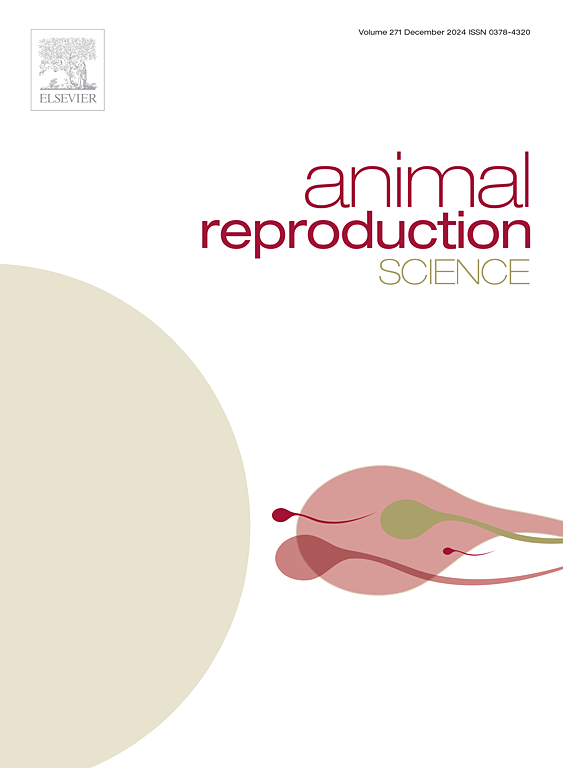基因失调损害异体猪妊娠胎盘血管生成
IF 3.3
2区 农林科学
Q1 AGRICULTURE, DAIRY & ANIMAL SCIENCE
引用次数: 0
摘要
胚胎移植(ET)是一种有价值的猪生殖技术,尽管由于胚胎死亡率高,其效率仍明显低于自然交配或人工授精(AI)。胎盘对胚胎存活和妊娠成功至关重要,它通过营养交换、激素产生和免疫调节来支持胚胎发育。因此,胎盘发育和功能的改变可能是ET效率降低的基础。为了研究这种功能障碍的分子机制,杂交(长白×大白)受体母猪在发情(第0天)开始时进行激素同步受精(对照组, = 8),或在发情后第5天手术转移23个胚(异体组, = 8)。在妊娠第18天(附着期)和第24天(早期胎盘),每组4头母猪采集胎盘样本。使用TruSeq搁浅mRNA试剂盒(Illumina)制备文库。测序在NextSeq 550平台上进行(2 ×75 bp对端),reads与Sus scrofa 11.1基因组对齐。差异基因表达分析(FC>2/<-2, P <; 0.05)显示异体胎盘中关键血管生成和免疫调节基因显著下调。在第18天,VEGFA、NOS3、FGF9、HIF1A、STAT1、STAT3、SMAD1、SMAD4、SMAD5和ETS1显著降低,表明血管重构和免疫调节受损。到第24天,SMAD2和其他免疫相关基因仍然失调。相反,ANGPTL2在第24天上调,可能是由于代偿性血管生成反应。数据表明,完全同种异体破坏了胎盘转录组程序,这对血管生成和免疫耐受至关重要,导致了猪ET后观察到的高胚胎死亡率。本文章由计算机程序翻译,如有差异,请以英文原文为准。
Gene dysregulation impairs placental angiogenesis in allogeneic pig pregnancies
Embryo transfer (ET) is a valuable reproductive technology in pigs, albeit its efficiency remains significantly lower than that of natural mating or artificial insemination (AI), owing to high embryonic death rates. Critical for embryo survival and pregnancy success is the placenta, which supports conceptus development through nutrient exchange, hormone production, and immune modulation. Alterations in placental development and function may therefore underlie the reduced efficiency of ET. To investigate the molecular mechanisms underlying this dysfunction, crossbred (Landrace × Large White) recipient sows were hormonally synchronized and either inseminated on the onset of estrus (Day 0), (Control group; n = 8) or surgically transferred 23 morulae on Day 5 post-estrus (Allogeneic group; n = 8). Placental samples were collected from four sows per group on Day 18 (attachment phase) and Day 24 (early placentation) of pregnancy. Libraries were prepared using the TruSeq Stranded mRNA kit (Illumina). Sequencing was performed on a NextSeq 550 platform (2 ×75 bp paired-end), and reads were aligned to the Sus scrofa 11.1 genome. Differential gene expression analysis (FC>2/<-2, P < 0.05) revealed significant downregulation of key angiogenic and immune-regulatory genes in allogeneic placentas. On Day 18, VEGFA, NOS3, FGF9, HIF1A, STAT1, STAT3, SMAD1, SMAD4, SMAD5, and ETS1 were markedly reduced, indicating impaired vascular remodeling and immune modulation. By Day 24, SMAD2 and additional immune-related genes remained dysregulated. Conversely, ANGPTL2 was upregulated on Day 24, possibly due to a compensatory angiogenic response. The data suggest that full allogeneicity disrupts placental transcriptomic programs crucial for angiogenesis and immune tolerance, contributing to the high embryonic mortality observed after ET in swine.
求助全文
通过发布文献求助,成功后即可免费获取论文全文。
去求助
来源期刊

Animal Reproduction Science
农林科学-奶制品与动物科学
CiteScore
4.50
自引率
9.10%
发文量
136
审稿时长
54 days
期刊介绍:
Animal Reproduction Science publishes results from studies relating to reproduction and fertility in animals. This includes both fundamental research and applied studies, including management practices that increase our understanding of the biology and manipulation of reproduction. Manuscripts should go into depth in the mechanisms involved in the research reported, rather than a give a mere description of findings. The focus is on animals that are useful to humans including food- and fibre-producing; companion/recreational; captive; and endangered species including zoo animals, but excluding laboratory animals unless the results of the study provide new information that impacts the basic understanding of the biology or manipulation of reproduction.
The journal''s scope includes the study of reproductive physiology and endocrinology, reproductive cycles, natural and artificial control of reproduction, preservation and use of gametes and embryos, pregnancy and parturition, infertility and sterility, diagnostic and therapeutic techniques.
The Editorial Board of Animal Reproduction Science has decided not to publish papers in which there is an exclusive examination of the in vitro development of oocytes and embryos; however, there will be consideration of papers that include in vitro studies where the source of the oocytes and/or development of the embryos beyond the blastocyst stage is part of the experimental design.
 求助内容:
求助内容: 应助结果提醒方式:
应助结果提醒方式:


